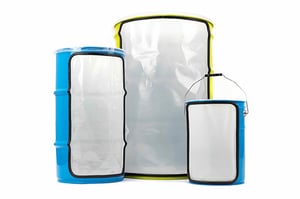Consider Materials and Durability to Find Your Solution
As more and more companies begin to think “out of the box” when it comes to modern packaging, an increasing number of them are discovering the versatility and value of liners for their drum and pail storage solutions. Choosing a liner will depend on a variety of factors, including what type of materials will be contained in the liner, capacity, temperature, and how contained materials will be accessed. If you are considering drum or pail liners, here are some factors you will want to consider.
 Size of the Container and Construction Materials
Size of the Container and Construction Materials
The size of your container and the materials it is constructed of will be important factors in choosing the right liner for your container.
Interestingly enough, if you are using pails and the pail is steel, you don't need to measure it because all steel pails are manufactured of the same size. If your container is plastic, you will need to measure its height.
Drums will generally be made of steel, plastic, or fiber materials and come in a variety of sizes. To ensure the proper fit of your liner, you will need to measure the height and diameter of the drum. The height of new drums is typically 34.25" and a standard 55-gallon liner will work. If a steel drum is reconditioned, however, the best options are either an accordion or combination liner. A combination liner (CBN) combines the straight-sided design with a band of accordion pleats to accommodate both drum height and variations in the drum's interior. Accordion liners have pleated side walls that accommodate variations in reconditioned drum heights.
The Type of Materials Being Stored
Another key element in choosing drum or pail liners is whether or not the type of material being stored has specific material or barrier requirements. Some examples of materials available and their typical uses include:
- High-density polyethylene liners (HDPE). These liners are rigid and durable. They are robust enough for a wide range of applications and have superior solvent resistance.
- Low-density polyethylene liners (LDPE). These are general-use liners. They provide superb tensile strength and elongation, as well as high resistance to tears and flex cracking. This liner is designed for applications of up to 175 degrees F.
- Anti-stat liners. These specific liners contain an internal agent to aid in the reduction of static build-up. This reduces dry chemical static cling and the chance of ignition of flammable materials.
- Conductive liners. Made from conductive plastic, these liners are engineered to absorb an electrical charge and move it safely to ground.
- High barrier foil. This is superior in providing a high oxygen and water vapor barrier and is constructed of sides made from a lamination of polypropylene-aluminum foil-polyethylene with the bottom constructed using a polyethylene-foil-polyester lamination.
Durability Requirements
There are a variety of options for pail and drum liners depending on durability needs. CDF’s heat seal technology is used to produce a flat seam and round bottom liners, such as our acclaimed LinerPro™ series. CDF’s proprietary impulse heat seal equipment enables us to seal polyethylene products, as well as difficult-to-seal specialty films, including:
- Metalized polyester and foil laminates for moisture protection
- Conductive laminates and anti-static films for volatile materials
- Nylon and co-extruded films for chemical resistance
- Polypropylene for high-temperature requirements
- Low-density polyethylene for general use
Custom Thermoforming
Thermoforming or vacuum-forming produces strong, semi-flexible, seamless, and leakproof inserts in a range of thicknesses. These thickness options help us address the most demanding applications. Our expertise in deep-draw thermoforming also allows us to produce parts up to an unprecedented 40″ deep in a variety of shapes. We use a selection of mold designs to produce cylindrical, tapered, or rectangular-shaped products.
CDF thermoforms FDA-approved LDPE and HDPE for routine applications, but we also work with:
- Polypropylene for high-temperature resistance
- Anti-static polyethylene for volatile materials
- EVOH for oxygen resistance
We also work with other materials upon request. If your process requires a liner thicker than a thermoform, blow-molded liners are ideal for heavy stress operations requiring maximum strength and protection.
The point is, if you are in search of pail or drum liners, we are experts in delivering products specifically for your needs. Dry or liquids, food grade or caustics, contact usto discuss your product liner options.

